Research Project: Digital Technologies' Implications on SME
VerifiedAdded on 2020/06/05
|30
|6237
|329
Project
AI Summary
This research project investigates the implications of digital technologies on Small and Medium Enterprises (SMEs), focusing on digital transformation, e-commerce, and the challenges of technology adoption. The project includes an introduction discussing the importance of digital technologies in the modern business environment, particularly for SMEs, and the benefits of IT spending. The research proposal outlines the aim, objectives, research questions, and rationale for the study, with a focus on the Nisa retail firm. The literature review explores the stages of digital transformation, challenges of integrating emerging technologies, the implications of digital technology, and the benefits of e-commerce for SMEs. The project aims to identify the impact of digital technologies on business activities and performance, analyze e-commerce benefits, and suggest ways for successful technology implementation. The project also touches upon the importance of stakeholder engagement and the significance of the study for small firms and scholars. The research aims to provide insights into the challenges and opportunities presented by digital technologies for SMEs, contributing to the understanding of how these businesses can leverage technology to improve their operations and competitiveness.
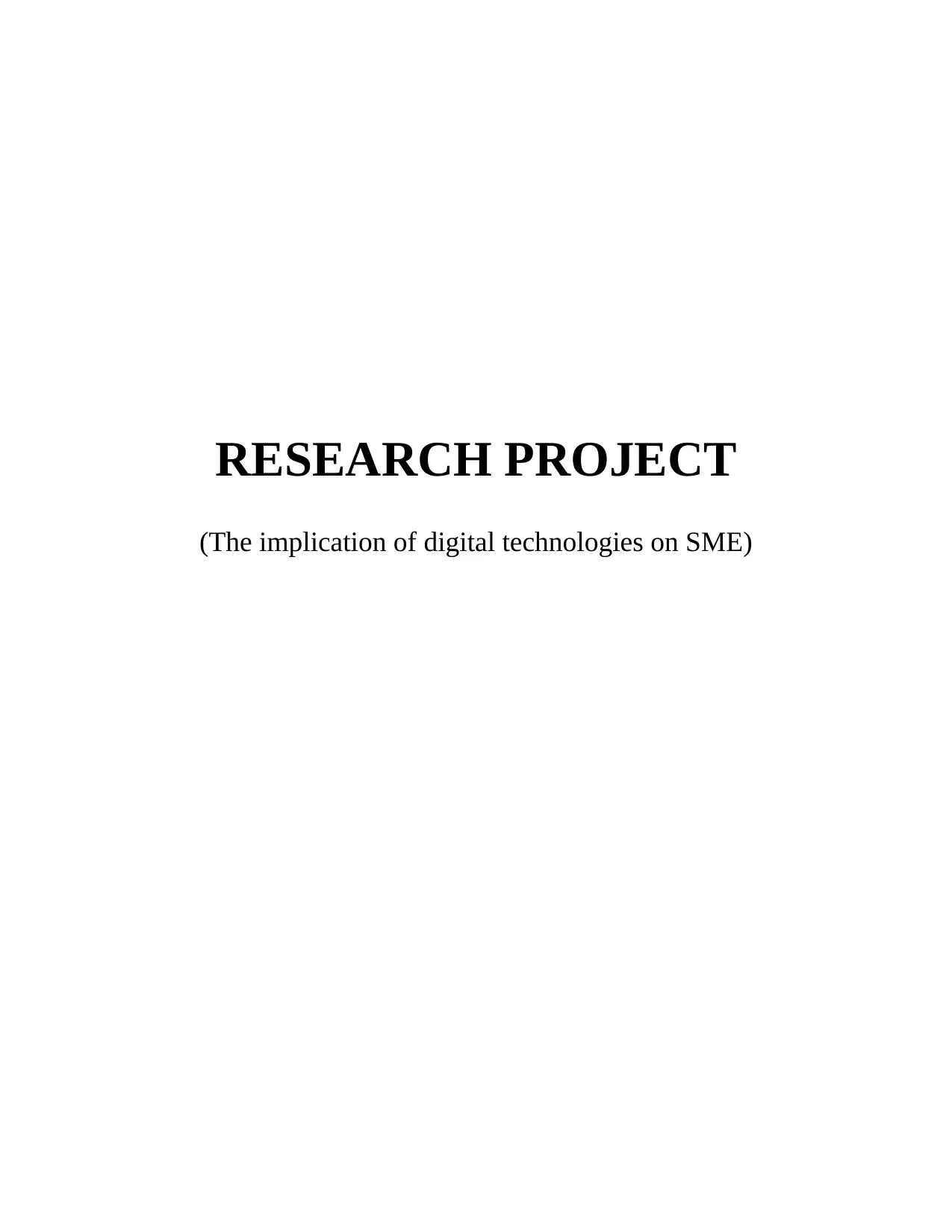
RESEARCH PROJECT
(The implication of digital technologies on SME)
(The implication of digital technologies on SME)
Paraphrase This Document
Need a fresh take? Get an instant paraphrase of this document with our AI Paraphraser
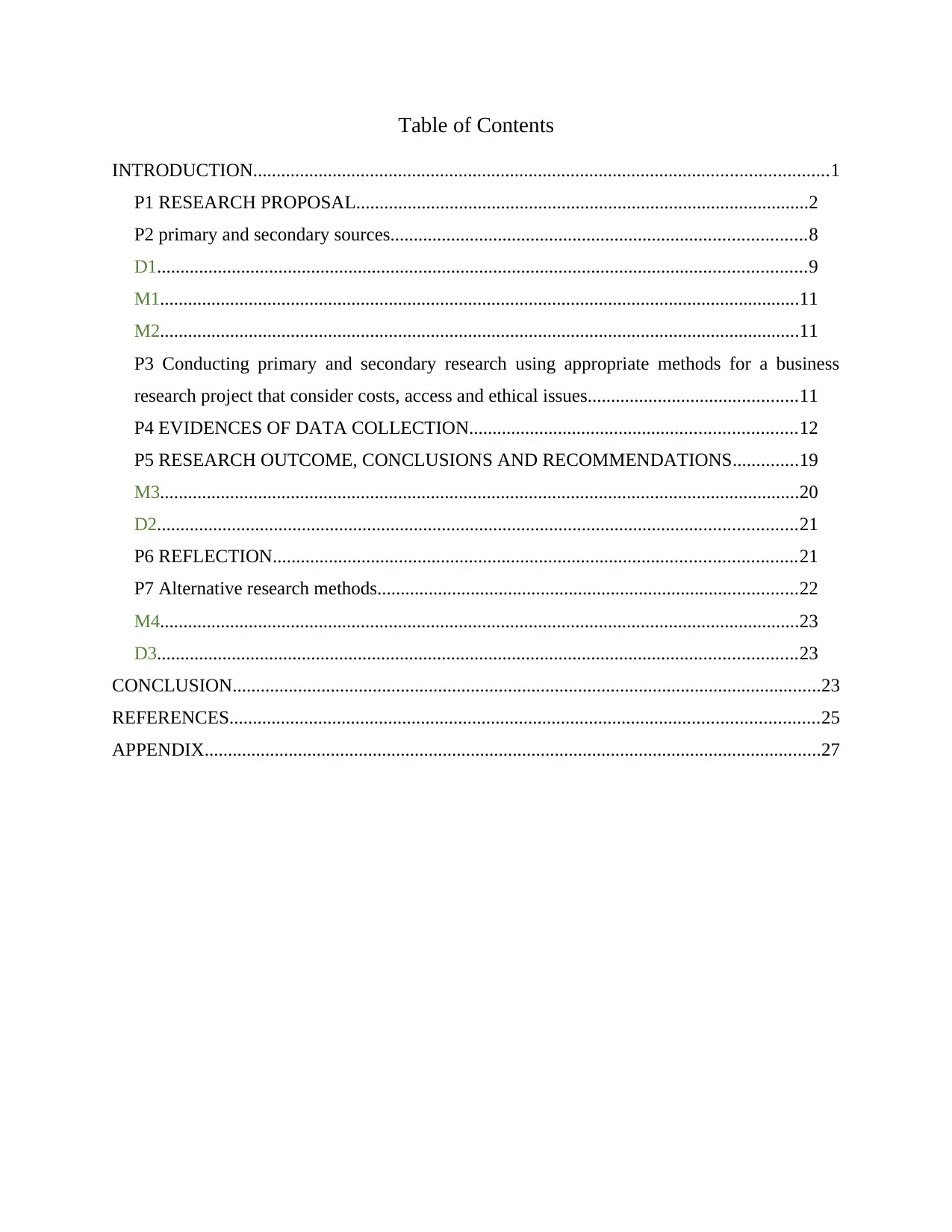
Table of Contents
INTRODUCTION...........................................................................................................................1
P1 RESEARCH PROPOSAL.................................................................................................2
P2 primary and secondary sources.........................................................................................8
D1...........................................................................................................................................9
M1.........................................................................................................................................11
M2.........................................................................................................................................11
P3 Conducting primary and secondary research using appropriate methods for a business
research project that consider costs, access and ethical issues.............................................11
P4 EVIDENCES OF DATA COLLECTION......................................................................12
P5 RESEARCH OUTCOME, CONCLUSIONS AND RECOMMENDATIONS..............19
M3.........................................................................................................................................20
D2.........................................................................................................................................21
P6 REFLECTION................................................................................................................21
P7 Alternative research methods..........................................................................................22
M4.........................................................................................................................................23
D3.........................................................................................................................................23
CONCLUSION..............................................................................................................................23
REFERENCES..............................................................................................................................25
APPENDIX....................................................................................................................................27
INTRODUCTION...........................................................................................................................1
P1 RESEARCH PROPOSAL.................................................................................................2
P2 primary and secondary sources.........................................................................................8
D1...........................................................................................................................................9
M1.........................................................................................................................................11
M2.........................................................................................................................................11
P3 Conducting primary and secondary research using appropriate methods for a business
research project that consider costs, access and ethical issues.............................................11
P4 EVIDENCES OF DATA COLLECTION......................................................................12
P5 RESEARCH OUTCOME, CONCLUSIONS AND RECOMMENDATIONS..............19
M3.........................................................................................................................................20
D2.........................................................................................................................................21
P6 REFLECTION................................................................................................................21
P7 Alternative research methods..........................................................................................22
M4.........................................................................................................................................23
D3.........................................................................................................................................23
CONCLUSION..............................................................................................................................23
REFERENCES..............................................................................................................................25
APPENDIX....................................................................................................................................27
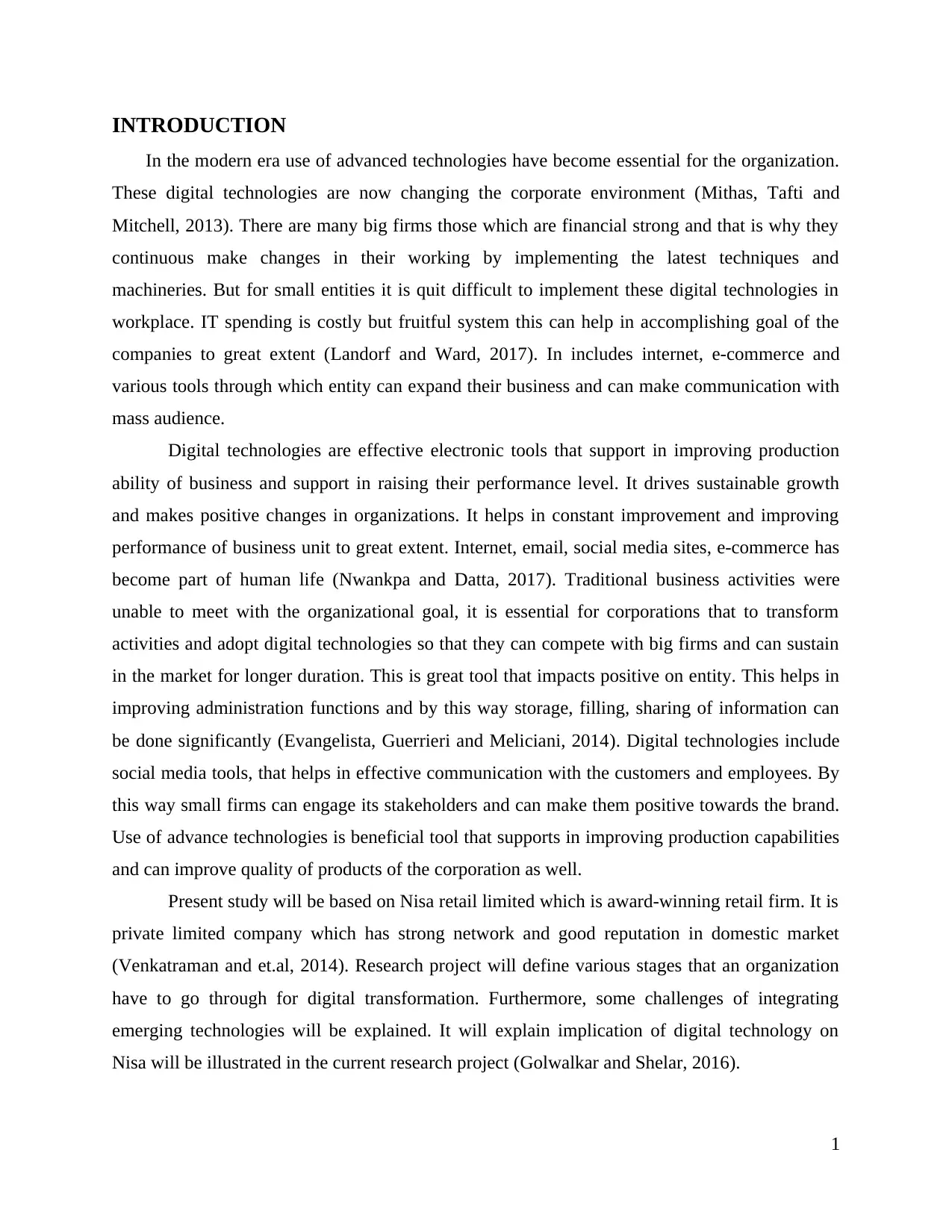
INTRODUCTION
In the modern era use of advanced technologies have become essential for the organization.
These digital technologies are now changing the corporate environment (Mithas, Tafti and
Mitchell, 2013). There are many big firms those which are financial strong and that is why they
continuous make changes in their working by implementing the latest techniques and
machineries. But for small entities it is quit difficult to implement these digital technologies in
workplace. IT spending is costly but fruitful system this can help in accomplishing goal of the
companies to great extent (Landorf and Ward, 2017). In includes internet, e-commerce and
various tools through which entity can expand their business and can make communication with
mass audience.
Digital technologies are effective electronic tools that support in improving production
ability of business and support in raising their performance level. It drives sustainable growth
and makes positive changes in organizations. It helps in constant improvement and improving
performance of business unit to great extent. Internet, email, social media sites, e-commerce has
become part of human life (Nwankpa and Datta, 2017). Traditional business activities were
unable to meet with the organizational goal, it is essential for corporations that to transform
activities and adopt digital technologies so that they can compete with big firms and can sustain
in the market for longer duration. This is great tool that impacts positive on entity. This helps in
improving administration functions and by this way storage, filling, sharing of information can
be done significantly (Evangelista, Guerrieri and Meliciani, 2014). Digital technologies include
social media tools, that helps in effective communication with the customers and employees. By
this way small firms can engage its stakeholders and can make them positive towards the brand.
Use of advance technologies is beneficial tool that supports in improving production capabilities
and can improve quality of products of the corporation as well.
Present study will be based on Nisa retail limited which is award-winning retail firm. It is
private limited company which has strong network and good reputation in domestic market
(Venkatraman and et.al, 2014). Research project will define various stages that an organization
have to go through for digital transformation. Furthermore, some challenges of integrating
emerging technologies will be explained. It will explain implication of digital technology on
Nisa will be illustrated in the current research project (Golwalkar and Shelar, 2016).
1
In the modern era use of advanced technologies have become essential for the organization.
These digital technologies are now changing the corporate environment (Mithas, Tafti and
Mitchell, 2013). There are many big firms those which are financial strong and that is why they
continuous make changes in their working by implementing the latest techniques and
machineries. But for small entities it is quit difficult to implement these digital technologies in
workplace. IT spending is costly but fruitful system this can help in accomplishing goal of the
companies to great extent (Landorf and Ward, 2017). In includes internet, e-commerce and
various tools through which entity can expand their business and can make communication with
mass audience.
Digital technologies are effective electronic tools that support in improving production
ability of business and support in raising their performance level. It drives sustainable growth
and makes positive changes in organizations. It helps in constant improvement and improving
performance of business unit to great extent. Internet, email, social media sites, e-commerce has
become part of human life (Nwankpa and Datta, 2017). Traditional business activities were
unable to meet with the organizational goal, it is essential for corporations that to transform
activities and adopt digital technologies so that they can compete with big firms and can sustain
in the market for longer duration. This is great tool that impacts positive on entity. This helps in
improving administration functions and by this way storage, filling, sharing of information can
be done significantly (Evangelista, Guerrieri and Meliciani, 2014). Digital technologies include
social media tools, that helps in effective communication with the customers and employees. By
this way small firms can engage its stakeholders and can make them positive towards the brand.
Use of advance technologies is beneficial tool that supports in improving production capabilities
and can improve quality of products of the corporation as well.
Present study will be based on Nisa retail limited which is award-winning retail firm. It is
private limited company which has strong network and good reputation in domestic market
(Venkatraman and et.al, 2014). Research project will define various stages that an organization
have to go through for digital transformation. Furthermore, some challenges of integrating
emerging technologies will be explained. It will explain implication of digital technology on
Nisa will be illustrated in the current research project (Golwalkar and Shelar, 2016).
1
⊘ This is a preview!⊘
Do you want full access?
Subscribe today to unlock all pages.

Trusted by 1+ million students worldwide
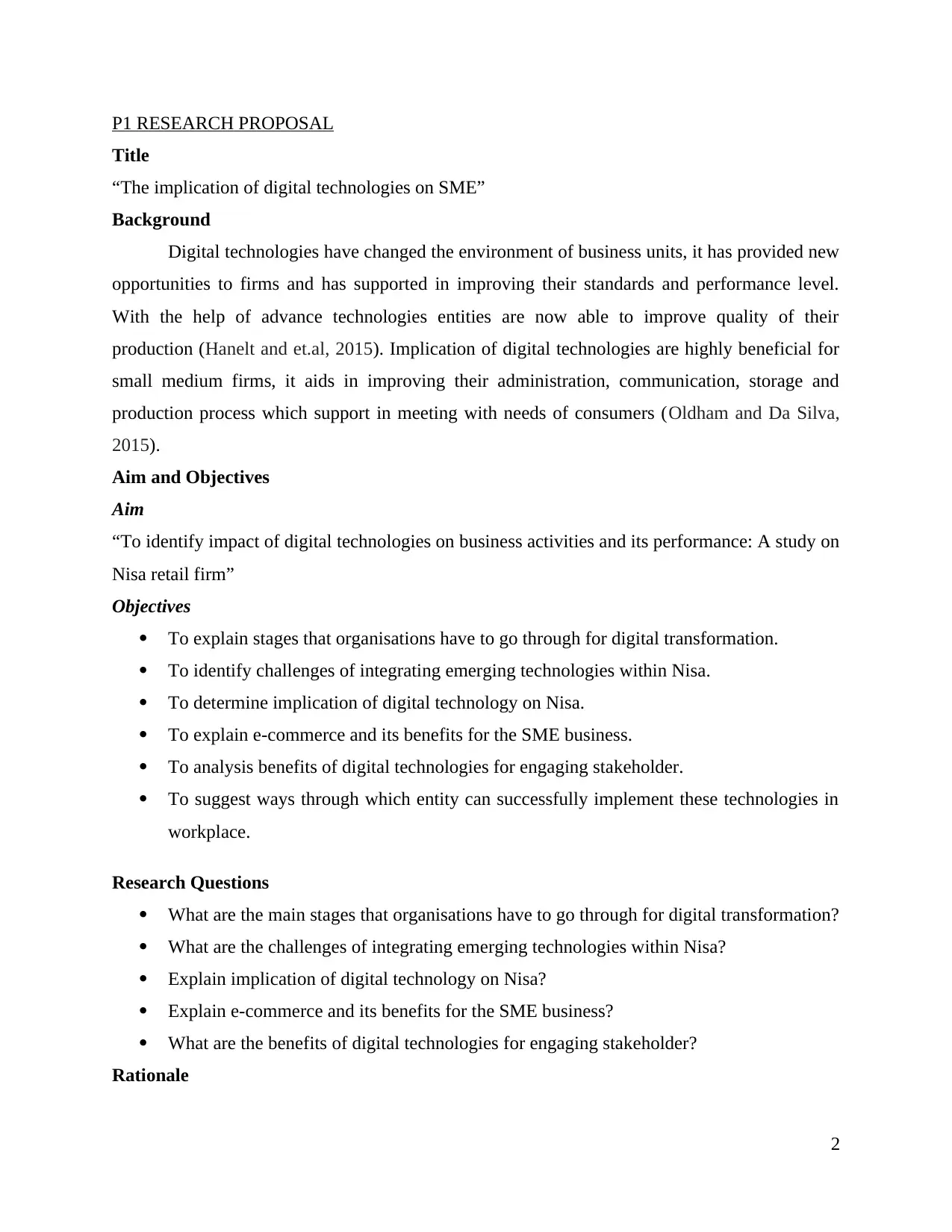
P1 RESEARCH PROPOSAL
Title
“The implication of digital technologies on SME”
Background
Digital technologies have changed the environment of business units, it has provided new
opportunities to firms and has supported in improving their standards and performance level.
With the help of advance technologies entities are now able to improve quality of their
production (Hanelt and et.al, 2015). Implication of digital technologies are highly beneficial for
small medium firms, it aids in improving their administration, communication, storage and
production process which support in meeting with needs of consumers (Oldham and Da Silva,
2015).
Aim and Objectives
Aim
“To identify impact of digital technologies on business activities and its performance: A study on
Nisa retail firm”
Objectives
To explain stages that organisations have to go through for digital transformation.
To identify challenges of integrating emerging technologies within Nisa.
To determine implication of digital technology on Nisa.
To explain e-commerce and its benefits for the SME business.
To analysis benefits of digital technologies for engaging stakeholder.
To suggest ways through which entity can successfully implement these technologies in
workplace.
Research Questions
What are the main stages that organisations have to go through for digital transformation?
What are the challenges of integrating emerging technologies within Nisa?
Explain implication of digital technology on Nisa?
Explain e-commerce and its benefits for the SME business?
What are the benefits of digital technologies for engaging stakeholder?
Rationale
2
Title
“The implication of digital technologies on SME”
Background
Digital technologies have changed the environment of business units, it has provided new
opportunities to firms and has supported in improving their standards and performance level.
With the help of advance technologies entities are now able to improve quality of their
production (Hanelt and et.al, 2015). Implication of digital technologies are highly beneficial for
small medium firms, it aids in improving their administration, communication, storage and
production process which support in meeting with needs of consumers (Oldham and Da Silva,
2015).
Aim and Objectives
Aim
“To identify impact of digital technologies on business activities and its performance: A study on
Nisa retail firm”
Objectives
To explain stages that organisations have to go through for digital transformation.
To identify challenges of integrating emerging technologies within Nisa.
To determine implication of digital technology on Nisa.
To explain e-commerce and its benefits for the SME business.
To analysis benefits of digital technologies for engaging stakeholder.
To suggest ways through which entity can successfully implement these technologies in
workplace.
Research Questions
What are the main stages that organisations have to go through for digital transformation?
What are the challenges of integrating emerging technologies within Nisa?
Explain implication of digital technology on Nisa?
Explain e-commerce and its benefits for the SME business?
What are the benefits of digital technologies for engaging stakeholder?
Rationale
2
Paraphrase This Document
Need a fresh take? Get an instant paraphrase of this document with our AI Paraphraser
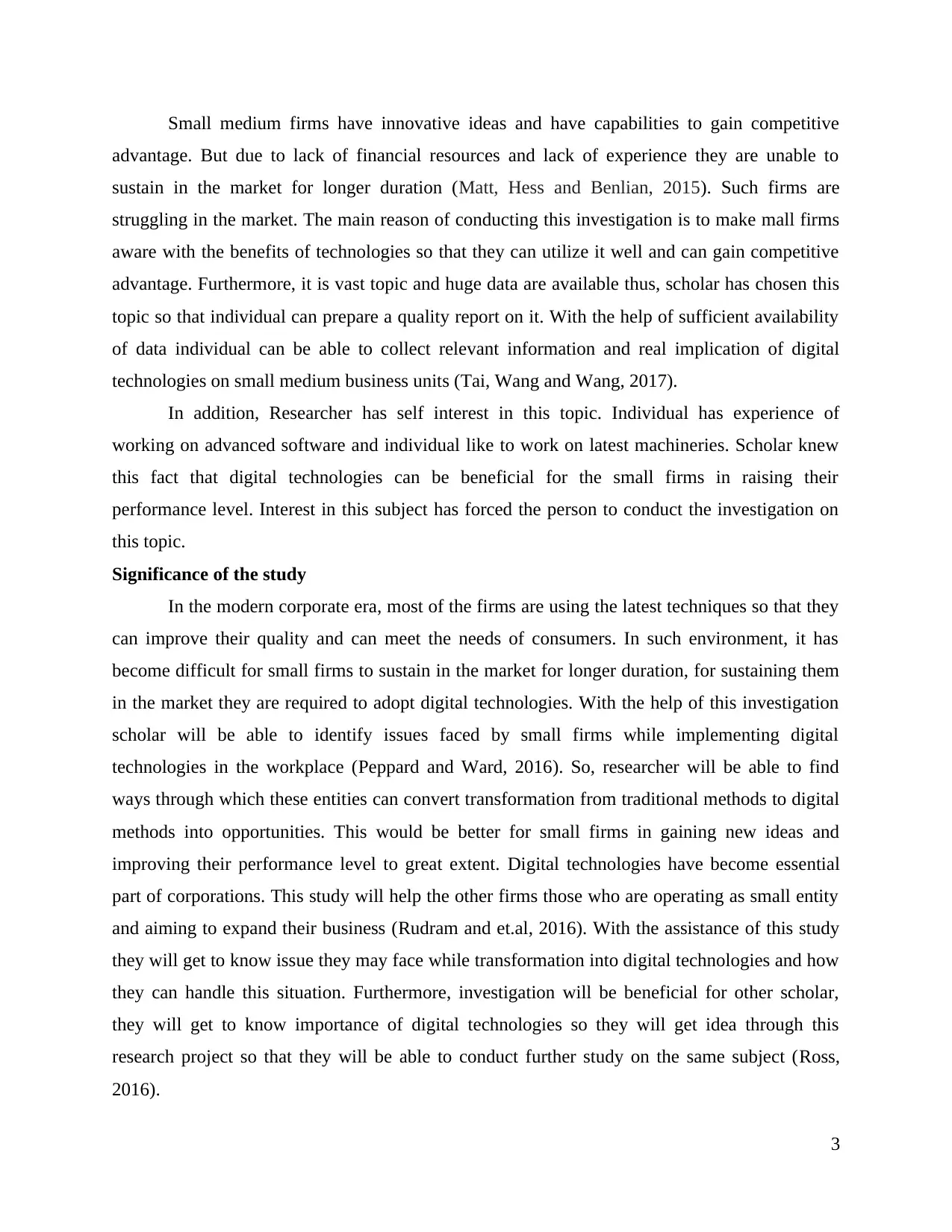
Small medium firms have innovative ideas and have capabilities to gain competitive
advantage. But due to lack of financial resources and lack of experience they are unable to
sustain in the market for longer duration (Matt, Hess and Benlian, 2015). Such firms are
struggling in the market. The main reason of conducting this investigation is to make mall firms
aware with the benefits of technologies so that they can utilize it well and can gain competitive
advantage. Furthermore, it is vast topic and huge data are available thus, scholar has chosen this
topic so that individual can prepare a quality report on it. With the help of sufficient availability
of data individual can be able to collect relevant information and real implication of digital
technologies on small medium business units (Tai, Wang and Wang, 2017).
In addition, Researcher has self interest in this topic. Individual has experience of
working on advanced software and individual like to work on latest machineries. Scholar knew
this fact that digital technologies can be beneficial for the small firms in raising their
performance level. Interest in this subject has forced the person to conduct the investigation on
this topic.
Significance of the study
In the modern corporate era, most of the firms are using the latest techniques so that they
can improve their quality and can meet the needs of consumers. In such environment, it has
become difficult for small firms to sustain in the market for longer duration, for sustaining them
in the market they are required to adopt digital technologies. With the help of this investigation
scholar will be able to identify issues faced by small firms while implementing digital
technologies in the workplace (Peppard and Ward, 2016). So, researcher will be able to find
ways through which these entities can convert transformation from traditional methods to digital
methods into opportunities. This would be better for small firms in gaining new ideas and
improving their performance level to great extent. Digital technologies have become essential
part of corporations. This study will help the other firms those who are operating as small entity
and aiming to expand their business (Rudram and et.al, 2016). With the assistance of this study
they will get to know issue they may face while transformation into digital technologies and how
they can handle this situation. Furthermore, investigation will be beneficial for other scholar,
they will get to know importance of digital technologies so they will get idea through this
research project so that they will be able to conduct further study on the same subject (Ross,
2016).
3
advantage. But due to lack of financial resources and lack of experience they are unable to
sustain in the market for longer duration (Matt, Hess and Benlian, 2015). Such firms are
struggling in the market. The main reason of conducting this investigation is to make mall firms
aware with the benefits of technologies so that they can utilize it well and can gain competitive
advantage. Furthermore, it is vast topic and huge data are available thus, scholar has chosen this
topic so that individual can prepare a quality report on it. With the help of sufficient availability
of data individual can be able to collect relevant information and real implication of digital
technologies on small medium business units (Tai, Wang and Wang, 2017).
In addition, Researcher has self interest in this topic. Individual has experience of
working on advanced software and individual like to work on latest machineries. Scholar knew
this fact that digital technologies can be beneficial for the small firms in raising their
performance level. Interest in this subject has forced the person to conduct the investigation on
this topic.
Significance of the study
In the modern corporate era, most of the firms are using the latest techniques so that they
can improve their quality and can meet the needs of consumers. In such environment, it has
become difficult for small firms to sustain in the market for longer duration, for sustaining them
in the market they are required to adopt digital technologies. With the help of this investigation
scholar will be able to identify issues faced by small firms while implementing digital
technologies in the workplace (Peppard and Ward, 2016). So, researcher will be able to find
ways through which these entities can convert transformation from traditional methods to digital
methods into opportunities. This would be better for small firms in gaining new ideas and
improving their performance level to great extent. Digital technologies have become essential
part of corporations. This study will help the other firms those who are operating as small entity
and aiming to expand their business (Rudram and et.al, 2016). With the assistance of this study
they will get to know issue they may face while transformation into digital technologies and how
they can handle this situation. Furthermore, investigation will be beneficial for other scholar,
they will get to know importance of digital technologies so they will get idea through this
research project so that they will be able to conduct further study on the same subject (Ross,
2016).
3
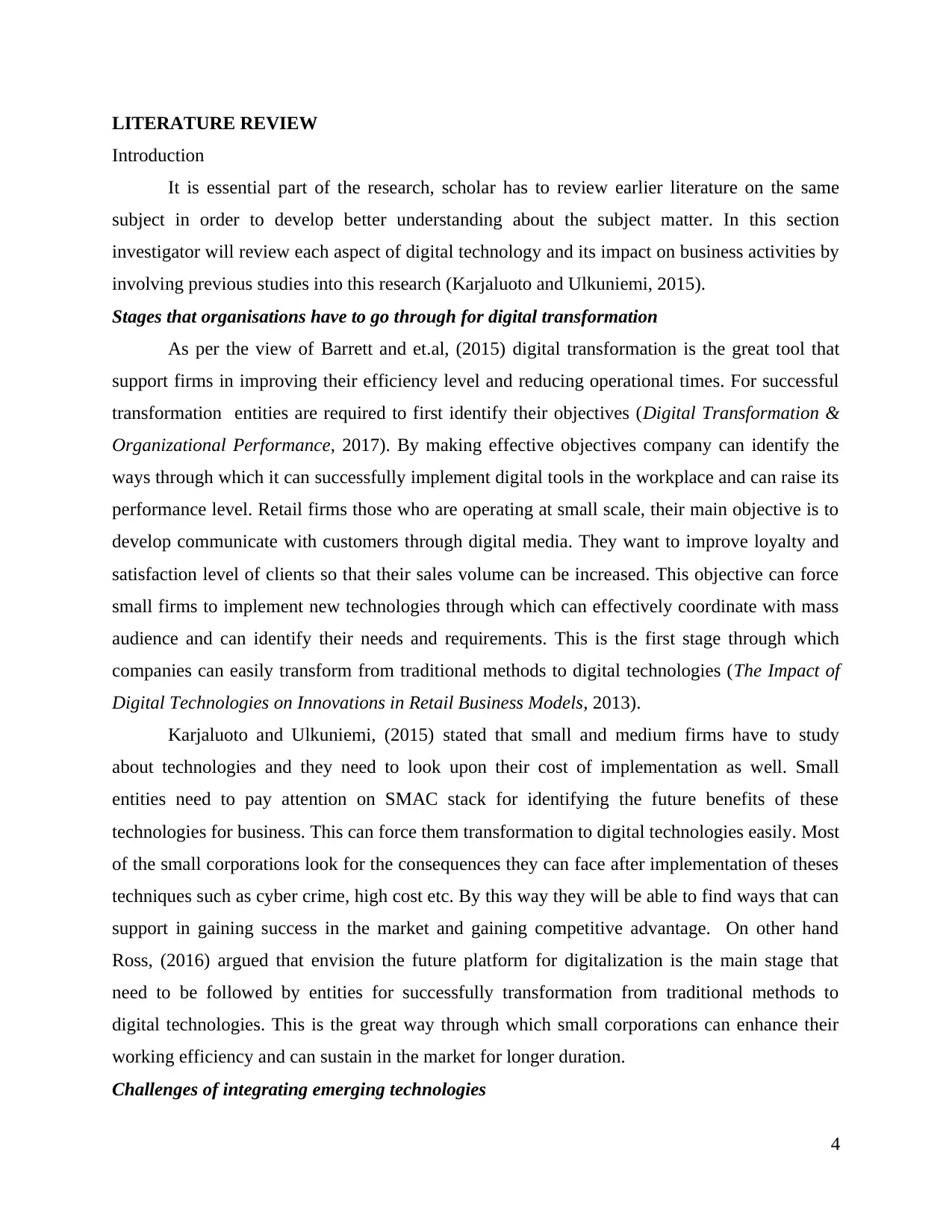
LITERATURE REVIEW
Introduction
It is essential part of the research, scholar has to review earlier literature on the same
subject in order to develop better understanding about the subject matter. In this section
investigator will review each aspect of digital technology and its impact on business activities by
involving previous studies into this research (Karjaluoto and Ulkuniemi, 2015).
Stages that organisations have to go through for digital transformation
As per the view of Barrett and et.al, (2015) digital transformation is the great tool that
support firms in improving their efficiency level and reducing operational times. For successful
transformation entities are required to first identify their objectives (Digital Transformation &
Organizational Performance, 2017). By making effective objectives company can identify the
ways through which it can successfully implement digital tools in the workplace and can raise its
performance level. Retail firms those who are operating at small scale, their main objective is to
develop communicate with customers through digital media. They want to improve loyalty and
satisfaction level of clients so that their sales volume can be increased. This objective can force
small firms to implement new technologies through which can effectively coordinate with mass
audience and can identify their needs and requirements. This is the first stage through which
companies can easily transform from traditional methods to digital technologies (The Impact of
Digital Technologies on Innovations in Retail Business Models, 2013).
Karjaluoto and Ulkuniemi, (2015) stated that small and medium firms have to study
about technologies and they need to look upon their cost of implementation as well. Small
entities need to pay attention on SMAC stack for identifying the future benefits of these
technologies for business. This can force them transformation to digital technologies easily. Most
of the small corporations look for the consequences they can face after implementation of theses
techniques such as cyber crime, high cost etc. By this way they will be able to find ways that can
support in gaining success in the market and gaining competitive advantage. On other hand
Ross, (2016) argued that envision the future platform for digitalization is the main stage that
need to be followed by entities for successfully transformation from traditional methods to
digital technologies. This is the great way through which small corporations can enhance their
working efficiency and can sustain in the market for longer duration.
Challenges of integrating emerging technologies
4
Introduction
It is essential part of the research, scholar has to review earlier literature on the same
subject in order to develop better understanding about the subject matter. In this section
investigator will review each aspect of digital technology and its impact on business activities by
involving previous studies into this research (Karjaluoto and Ulkuniemi, 2015).
Stages that organisations have to go through for digital transformation
As per the view of Barrett and et.al, (2015) digital transformation is the great tool that
support firms in improving their efficiency level and reducing operational times. For successful
transformation entities are required to first identify their objectives (Digital Transformation &
Organizational Performance, 2017). By making effective objectives company can identify the
ways through which it can successfully implement digital tools in the workplace and can raise its
performance level. Retail firms those who are operating at small scale, their main objective is to
develop communicate with customers through digital media. They want to improve loyalty and
satisfaction level of clients so that their sales volume can be increased. This objective can force
small firms to implement new technologies through which can effectively coordinate with mass
audience and can identify their needs and requirements. This is the first stage through which
companies can easily transform from traditional methods to digital technologies (The Impact of
Digital Technologies on Innovations in Retail Business Models, 2013).
Karjaluoto and Ulkuniemi, (2015) stated that small and medium firms have to study
about technologies and they need to look upon their cost of implementation as well. Small
entities need to pay attention on SMAC stack for identifying the future benefits of these
technologies for business. This can force them transformation to digital technologies easily. Most
of the small corporations look for the consequences they can face after implementation of theses
techniques such as cyber crime, high cost etc. By this way they will be able to find ways that can
support in gaining success in the market and gaining competitive advantage. On other hand
Ross, (2016) argued that envision the future platform for digitalization is the main stage that
need to be followed by entities for successfully transformation from traditional methods to
digital technologies. This is the great way through which small corporations can enhance their
working efficiency and can sustain in the market for longer duration.
Challenges of integrating emerging technologies
4
⊘ This is a preview!⊘
Do you want full access?
Subscribe today to unlock all pages.

Trusted by 1+ million students worldwide
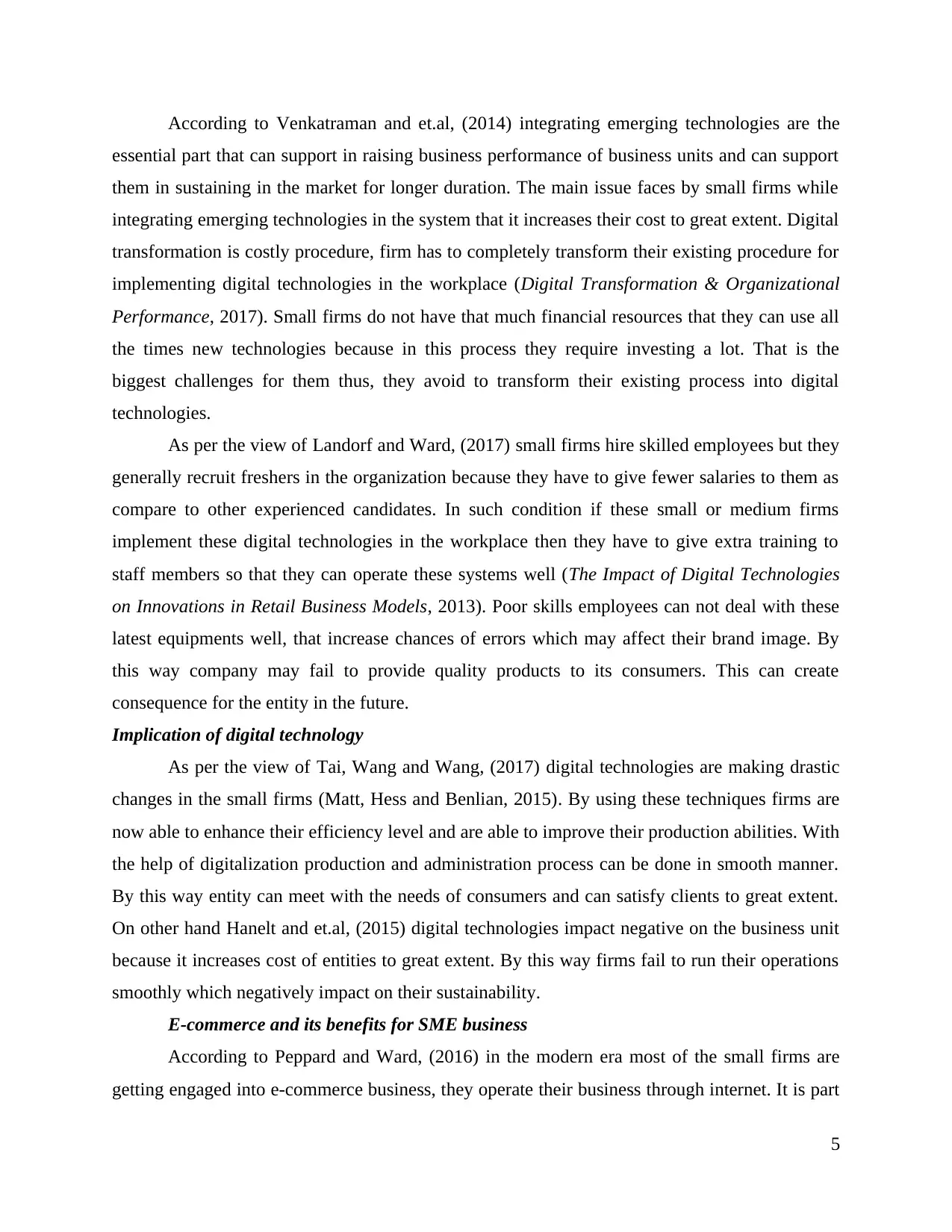
According to Venkatraman and et.al, (2014) integrating emerging technologies are the
essential part that can support in raising business performance of business units and can support
them in sustaining in the market for longer duration. The main issue faces by small firms while
integrating emerging technologies in the system that it increases their cost to great extent. Digital
transformation is costly procedure, firm has to completely transform their existing procedure for
implementing digital technologies in the workplace (Digital Transformation & Organizational
Performance, 2017). Small firms do not have that much financial resources that they can use all
the times new technologies because in this process they require investing a lot. That is the
biggest challenges for them thus, they avoid to transform their existing process into digital
technologies.
As per the view of Landorf and Ward, (2017) small firms hire skilled employees but they
generally recruit freshers in the organization because they have to give fewer salaries to them as
compare to other experienced candidates. In such condition if these small or medium firms
implement these digital technologies in the workplace then they have to give extra training to
staff members so that they can operate these systems well (The Impact of Digital Technologies
on Innovations in Retail Business Models, 2013). Poor skills employees can not deal with these
latest equipments well, that increase chances of errors which may affect their brand image. By
this way company may fail to provide quality products to its consumers. This can create
consequence for the entity in the future.
Implication of digital technology
As per the view of Tai, Wang and Wang, (2017) digital technologies are making drastic
changes in the small firms (Matt, Hess and Benlian, 2015). By using these techniques firms are
now able to enhance their efficiency level and are able to improve their production abilities. With
the help of digitalization production and administration process can be done in smooth manner.
By this way entity can meet with the needs of consumers and can satisfy clients to great extent.
On other hand Hanelt and et.al, (2015) digital technologies impact negative on the business unit
because it increases cost of entities to great extent. By this way firms fail to run their operations
smoothly which negatively impact on their sustainability.
E-commerce and its benefits for SME business
According to Peppard and Ward, (2016) in the modern era most of the small firms are
getting engaged into e-commerce business, they operate their business through internet. It is part
5
essential part that can support in raising business performance of business units and can support
them in sustaining in the market for longer duration. The main issue faces by small firms while
integrating emerging technologies in the system that it increases their cost to great extent. Digital
transformation is costly procedure, firm has to completely transform their existing procedure for
implementing digital technologies in the workplace (Digital Transformation & Organizational
Performance, 2017). Small firms do not have that much financial resources that they can use all
the times new technologies because in this process they require investing a lot. That is the
biggest challenges for them thus, they avoid to transform their existing process into digital
technologies.
As per the view of Landorf and Ward, (2017) small firms hire skilled employees but they
generally recruit freshers in the organization because they have to give fewer salaries to them as
compare to other experienced candidates. In such condition if these small or medium firms
implement these digital technologies in the workplace then they have to give extra training to
staff members so that they can operate these systems well (The Impact of Digital Technologies
on Innovations in Retail Business Models, 2013). Poor skills employees can not deal with these
latest equipments well, that increase chances of errors which may affect their brand image. By
this way company may fail to provide quality products to its consumers. This can create
consequence for the entity in the future.
Implication of digital technology
As per the view of Tai, Wang and Wang, (2017) digital technologies are making drastic
changes in the small firms (Matt, Hess and Benlian, 2015). By using these techniques firms are
now able to enhance their efficiency level and are able to improve their production abilities. With
the help of digitalization production and administration process can be done in smooth manner.
By this way entity can meet with the needs of consumers and can satisfy clients to great extent.
On other hand Hanelt and et.al, (2015) digital technologies impact negative on the business unit
because it increases cost of entities to great extent. By this way firms fail to run their operations
smoothly which negatively impact on their sustainability.
E-commerce and its benefits for SME business
According to Peppard and Ward, (2016) in the modern era most of the small firms are
getting engaged into e-commerce business, they operate their business through internet. It is part
5
Paraphrase This Document
Need a fresh take? Get an instant paraphrase of this document with our AI Paraphraser
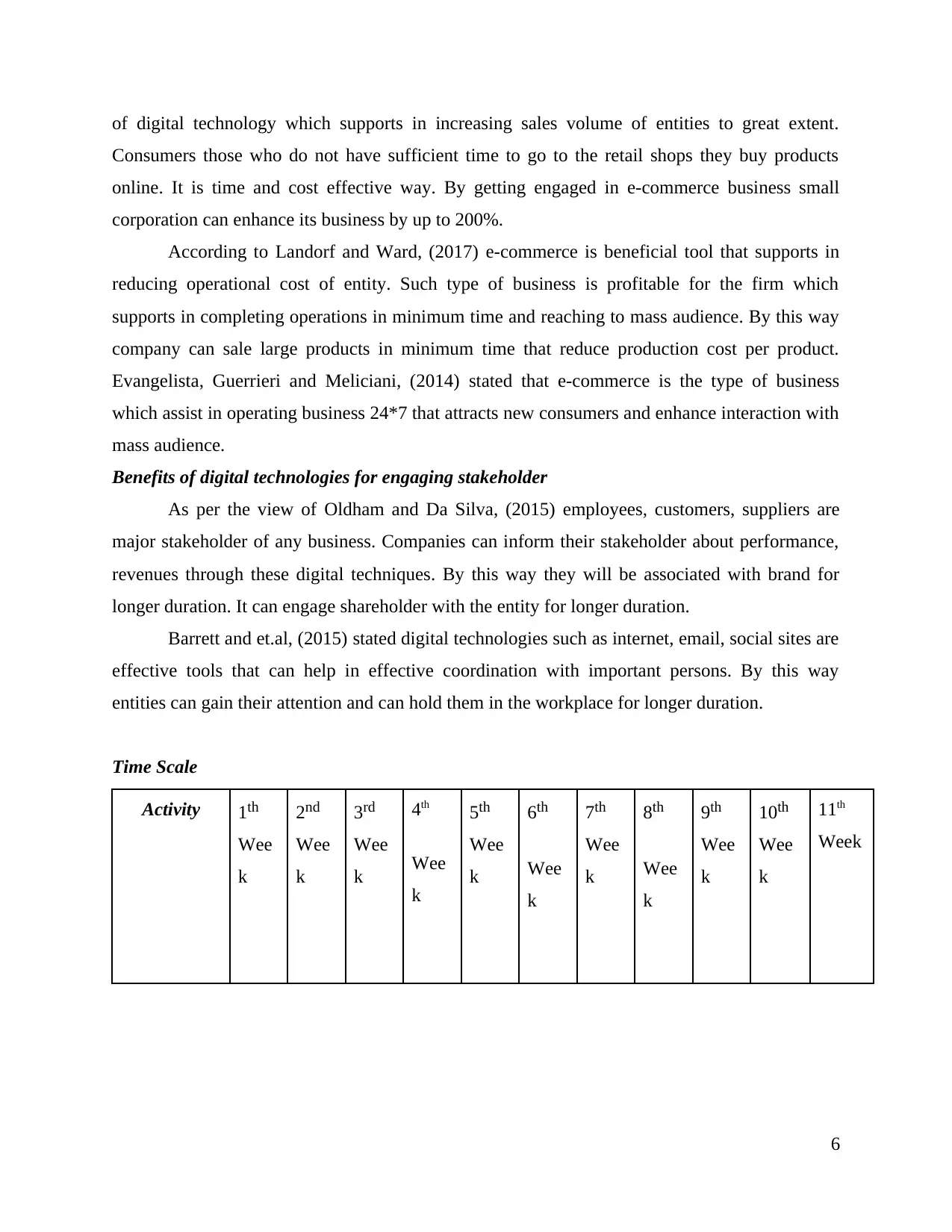
of digital technology which supports in increasing sales volume of entities to great extent.
Consumers those who do not have sufficient time to go to the retail shops they buy products
online. It is time and cost effective way. By getting engaged in e-commerce business small
corporation can enhance its business by up to 200%.
According to Landorf and Ward, (2017) e-commerce is beneficial tool that supports in
reducing operational cost of entity. Such type of business is profitable for the firm which
supports in completing operations in minimum time and reaching to mass audience. By this way
company can sale large products in minimum time that reduce production cost per product.
Evangelista, Guerrieri and Meliciani, (2014) stated that e-commerce is the type of business
which assist in operating business 24*7 that attracts new consumers and enhance interaction with
mass audience.
Benefits of digital technologies for engaging stakeholder
As per the view of Oldham and Da Silva, (2015) employees, customers, suppliers are
major stakeholder of any business. Companies can inform their stakeholder about performance,
revenues through these digital techniques. By this way they will be associated with brand for
longer duration. It can engage shareholder with the entity for longer duration.
Barrett and et.al, (2015) stated digital technologies such as internet, email, social sites are
effective tools that can help in effective coordination with important persons. By this way
entities can gain their attention and can hold them in the workplace for longer duration.
Time Scale
Activity 1th
Wee
k
2nd
Wee
k
3rd
Wee
k
4th
Wee
k
5th
Wee
k
6th
Wee
k
7th
Wee
k
8th
Wee
k
9th
Wee
k
10th
Wee
k
11th
Week
6
Consumers those who do not have sufficient time to go to the retail shops they buy products
online. It is time and cost effective way. By getting engaged in e-commerce business small
corporation can enhance its business by up to 200%.
According to Landorf and Ward, (2017) e-commerce is beneficial tool that supports in
reducing operational cost of entity. Such type of business is profitable for the firm which
supports in completing operations in minimum time and reaching to mass audience. By this way
company can sale large products in minimum time that reduce production cost per product.
Evangelista, Guerrieri and Meliciani, (2014) stated that e-commerce is the type of business
which assist in operating business 24*7 that attracts new consumers and enhance interaction with
mass audience.
Benefits of digital technologies for engaging stakeholder
As per the view of Oldham and Da Silva, (2015) employees, customers, suppliers are
major stakeholder of any business. Companies can inform their stakeholder about performance,
revenues through these digital techniques. By this way they will be associated with brand for
longer duration. It can engage shareholder with the entity for longer duration.
Barrett and et.al, (2015) stated digital technologies such as internet, email, social sites are
effective tools that can help in effective coordination with important persons. By this way
entities can gain their attention and can hold them in the workplace for longer duration.
Time Scale
Activity 1th
Wee
k
2nd
Wee
k
3rd
Wee
k
4th
Wee
k
5th
Wee
k
6th
Wee
k
7th
Wee
k
8th
Wee
k
9th
Wee
k
10th
Wee
k
11th
Week
6
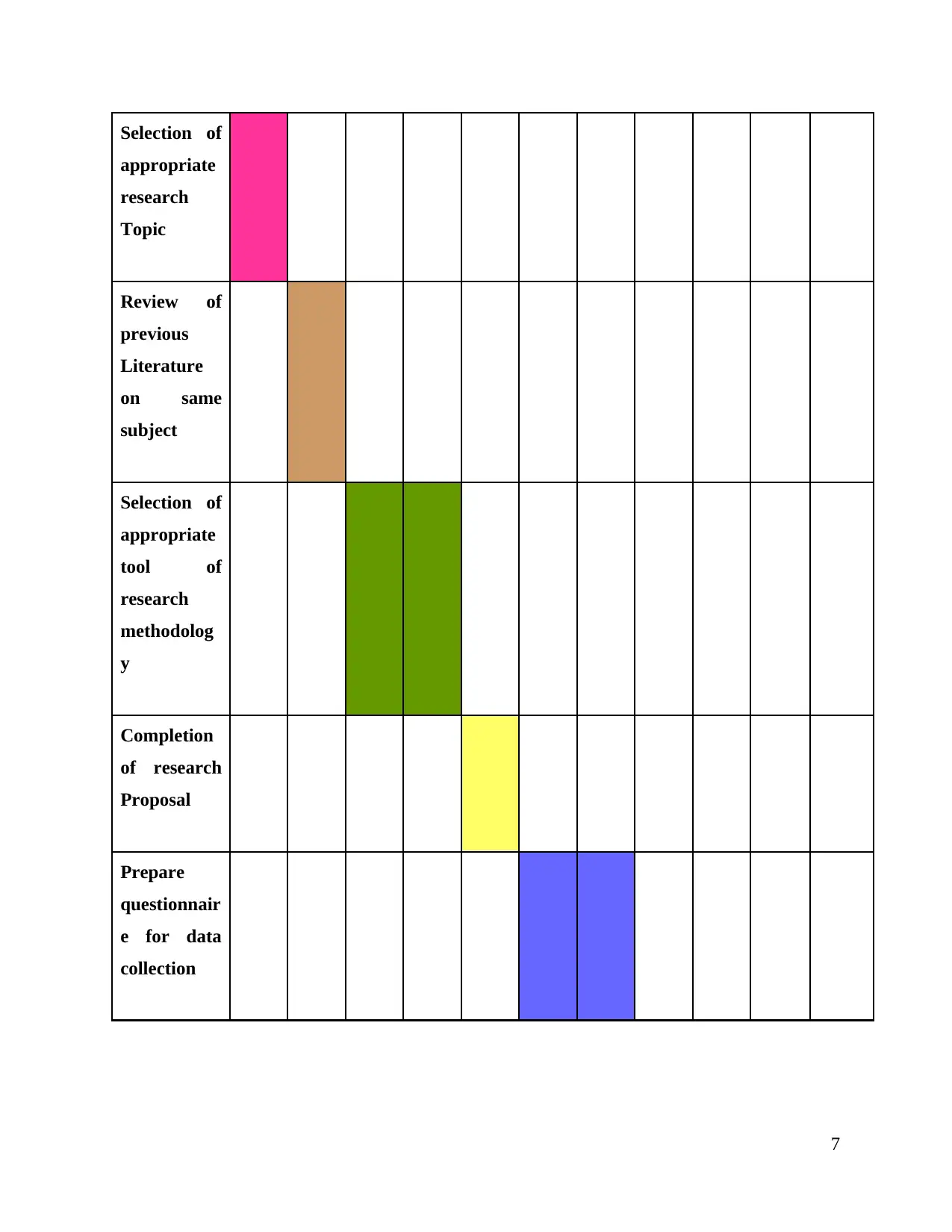
Selection of
appropriate
research
Topic
Review of
previous
Literature
on same
subject
Selection of
appropriate
tool of
research
methodolog
y
Completion
of research
Proposal
Prepare
questionnair
e for data
collection
7
appropriate
research
Topic
Review of
previous
Literature
on same
subject
Selection of
appropriate
tool of
research
methodolog
y
Completion
of research
Proposal
Prepare
questionnair
e for data
collection
7
⊘ This is a preview!⊘
Do you want full access?
Subscribe today to unlock all pages.

Trusted by 1+ million students worldwide
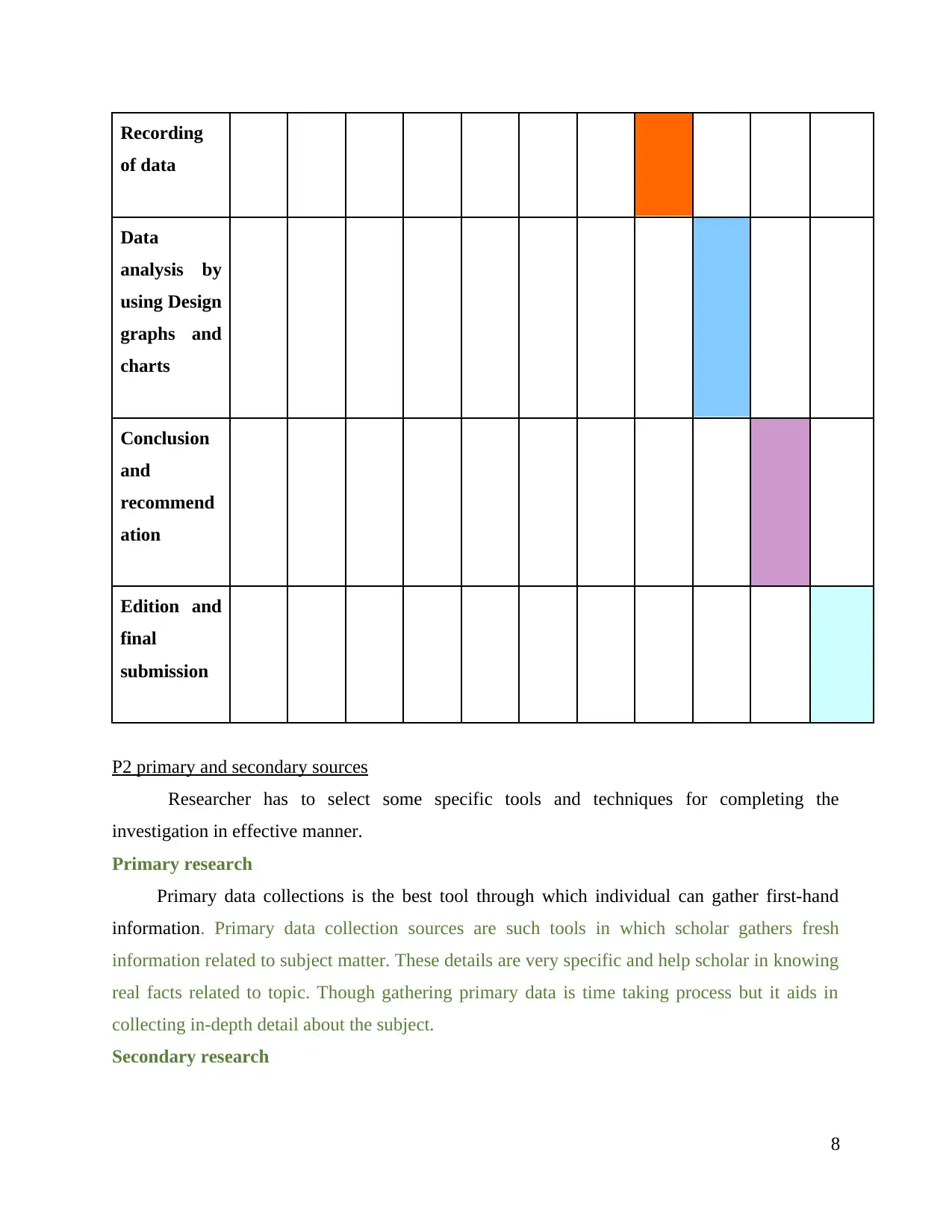
Recording
of data
Data
analysis by
using Design
graphs and
charts
Conclusion
and
recommend
ation
Edition and
final
submission
P2 primary and secondary sources
Researcher has to select some specific tools and techniques for completing the
investigation in effective manner.
Primary research
Primary data collections is the best tool through which individual can gather first-hand
information. Primary data collection sources are such tools in which scholar gathers fresh
information related to subject matter. These details are very specific and help scholar in knowing
real facts related to topic. Though gathering primary data is time taking process but it aids in
collecting in-depth detail about the subject.
Secondary research
8
of data
Data
analysis by
using Design
graphs and
charts
Conclusion
and
recommend
ation
Edition and
final
submission
P2 primary and secondary sources
Researcher has to select some specific tools and techniques for completing the
investigation in effective manner.
Primary research
Primary data collections is the best tool through which individual can gather first-hand
information. Primary data collection sources are such tools in which scholar gathers fresh
information related to subject matter. These details are very specific and help scholar in knowing
real facts related to topic. Though gathering primary data is time taking process but it aids in
collecting in-depth detail about the subject.
Secondary research
8
Paraphrase This Document
Need a fresh take? Get an instant paraphrase of this document with our AI Paraphraser
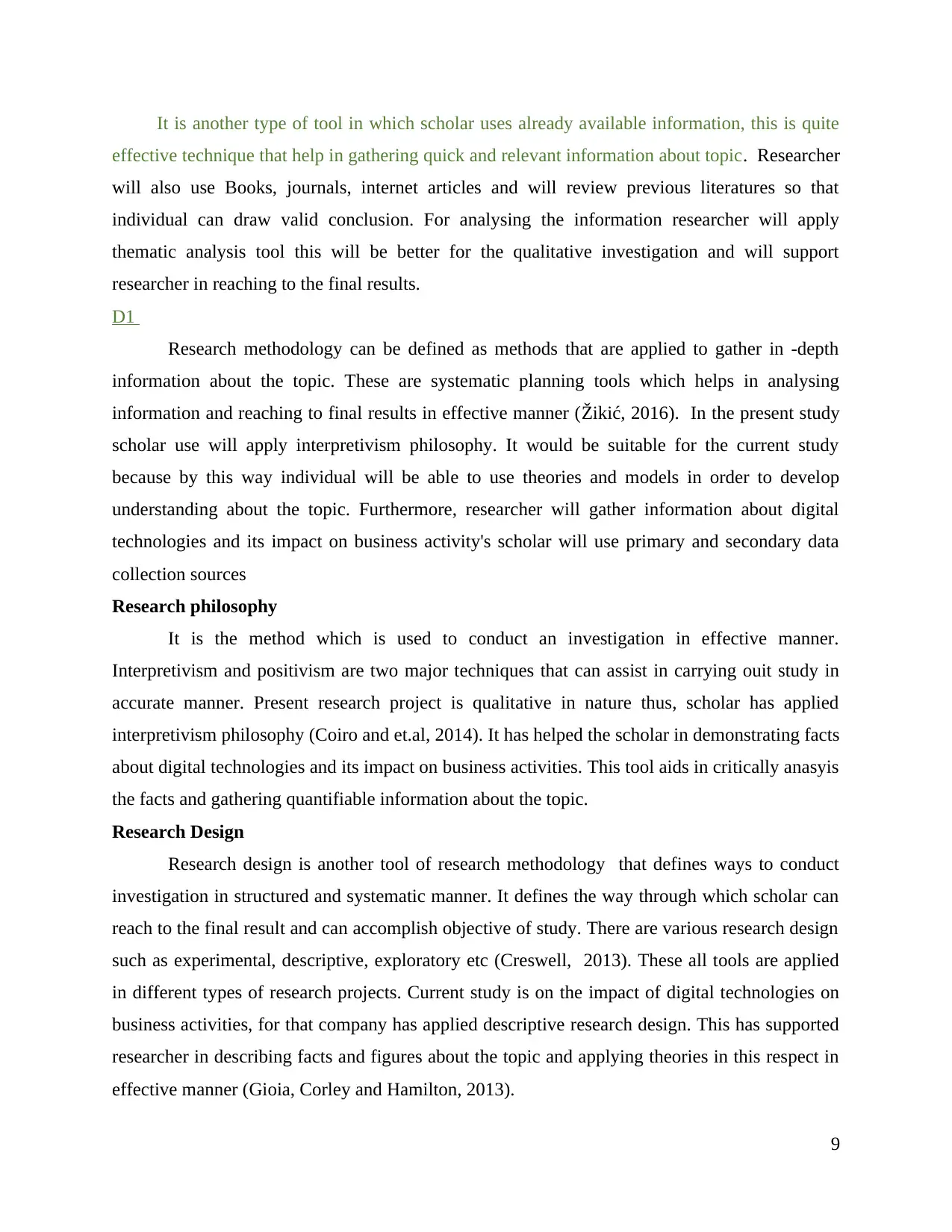
It is another type of tool in which scholar uses already available information, this is quite
effective technique that help in gathering quick and relevant information about topic. Researcher
will also use Books, journals, internet articles and will review previous literatures so that
individual can draw valid conclusion. For analysing the information researcher will apply
thematic analysis tool this will be better for the qualitative investigation and will support
researcher in reaching to the final results.
D1
Research methodology can be defined as methods that are applied to gather in -depth
information about the topic. These are systematic planning tools which helps in analysing
information and reaching to final results in effective manner (Žikić, 2016). In the present study
scholar use will apply interpretivism philosophy. It would be suitable for the current study
because by this way individual will be able to use theories and models in order to develop
understanding about the topic. Furthermore, researcher will gather information about digital
technologies and its impact on business activity's scholar will use primary and secondary data
collection sources
Research philosophy
It is the method which is used to conduct an investigation in effective manner.
Interpretivism and positivism are two major techniques that can assist in carrying ouit study in
accurate manner. Present research project is qualitative in nature thus, scholar has applied
interpretivism philosophy (Coiro and et.al, 2014). It has helped the scholar in demonstrating facts
about digital technologies and its impact on business activities. This tool aids in critically anasyis
the facts and gathering quantifiable information about the topic.
Research Design
Research design is another tool of research methodology that defines ways to conduct
investigation in structured and systematic manner. It defines the way through which scholar can
reach to the final result and can accomplish objective of study. There are various research design
such as experimental, descriptive, exploratory etc (Creswell, 2013). These all tools are applied
in different types of research projects. Current study is on the impact of digital technologies on
business activities, for that company has applied descriptive research design. This has supported
researcher in describing facts and figures about the topic and applying theories in this respect in
effective manner (Gioia, Corley and Hamilton, 2013).
9
effective technique that help in gathering quick and relevant information about topic. Researcher
will also use Books, journals, internet articles and will review previous literatures so that
individual can draw valid conclusion. For analysing the information researcher will apply
thematic analysis tool this will be better for the qualitative investigation and will support
researcher in reaching to the final results.
D1
Research methodology can be defined as methods that are applied to gather in -depth
information about the topic. These are systematic planning tools which helps in analysing
information and reaching to final results in effective manner (Žikić, 2016). In the present study
scholar use will apply interpretivism philosophy. It would be suitable for the current study
because by this way individual will be able to use theories and models in order to develop
understanding about the topic. Furthermore, researcher will gather information about digital
technologies and its impact on business activity's scholar will use primary and secondary data
collection sources
Research philosophy
It is the method which is used to conduct an investigation in effective manner.
Interpretivism and positivism are two major techniques that can assist in carrying ouit study in
accurate manner. Present research project is qualitative in nature thus, scholar has applied
interpretivism philosophy (Coiro and et.al, 2014). It has helped the scholar in demonstrating facts
about digital technologies and its impact on business activities. This tool aids in critically anasyis
the facts and gathering quantifiable information about the topic.
Research Design
Research design is another tool of research methodology that defines ways to conduct
investigation in structured and systematic manner. It defines the way through which scholar can
reach to the final result and can accomplish objective of study. There are various research design
such as experimental, descriptive, exploratory etc (Creswell, 2013). These all tools are applied
in different types of research projects. Current study is on the impact of digital technologies on
business activities, for that company has applied descriptive research design. This has supported
researcher in describing facts and figures about the topic and applying theories in this respect in
effective manner (Gioia, Corley and Hamilton, 2013).
9
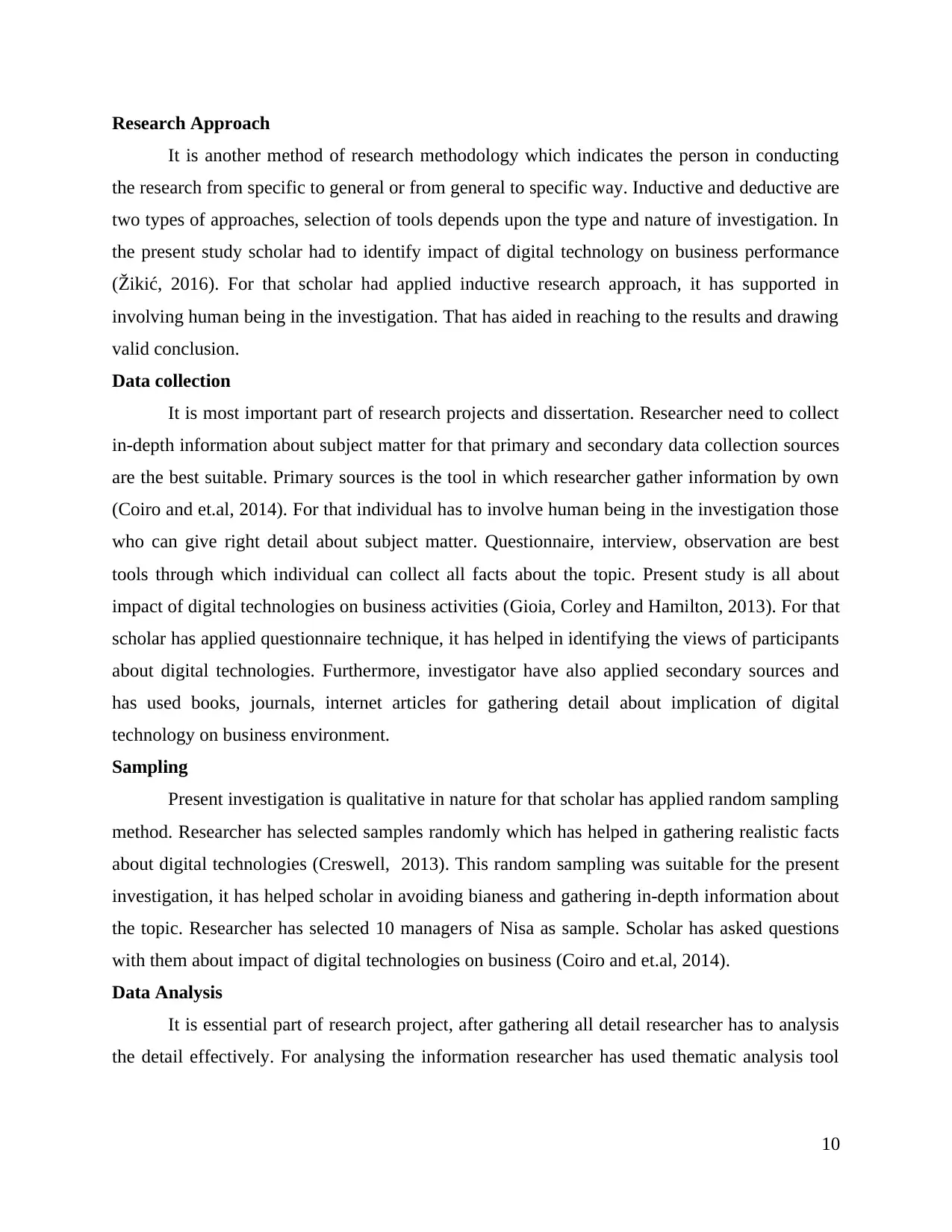
Research Approach
It is another method of research methodology which indicates the person in conducting
the research from specific to general or from general to specific way. Inductive and deductive are
two types of approaches, selection of tools depends upon the type and nature of investigation. In
the present study scholar had to identify impact of digital technology on business performance
(Žikić, 2016). For that scholar had applied inductive research approach, it has supported in
involving human being in the investigation. That has aided in reaching to the results and drawing
valid conclusion.
Data collection
It is most important part of research projects and dissertation. Researcher need to collect
in-depth information about subject matter for that primary and secondary data collection sources
are the best suitable. Primary sources is the tool in which researcher gather information by own
(Coiro and et.al, 2014). For that individual has to involve human being in the investigation those
who can give right detail about subject matter. Questionnaire, interview, observation are best
tools through which individual can collect all facts about the topic. Present study is all about
impact of digital technologies on business activities (Gioia, Corley and Hamilton, 2013). For that
scholar has applied questionnaire technique, it has helped in identifying the views of participants
about digital technologies. Furthermore, investigator have also applied secondary sources and
has used books, journals, internet articles for gathering detail about implication of digital
technology on business environment.
Sampling
Present investigation is qualitative in nature for that scholar has applied random sampling
method. Researcher has selected samples randomly which has helped in gathering realistic facts
about digital technologies (Creswell, 2013). This random sampling was suitable for the present
investigation, it has helped scholar in avoiding bianess and gathering in-depth information about
the topic. Researcher has selected 10 managers of Nisa as sample. Scholar has asked questions
with them about impact of digital technologies on business (Coiro and et.al, 2014).
Data Analysis
It is essential part of research project, after gathering all detail researcher has to analysis
the detail effectively. For analysing the information researcher has used thematic analysis tool
10
It is another method of research methodology which indicates the person in conducting
the research from specific to general or from general to specific way. Inductive and deductive are
two types of approaches, selection of tools depends upon the type and nature of investigation. In
the present study scholar had to identify impact of digital technology on business performance
(Žikić, 2016). For that scholar had applied inductive research approach, it has supported in
involving human being in the investigation. That has aided in reaching to the results and drawing
valid conclusion.
Data collection
It is most important part of research projects and dissertation. Researcher need to collect
in-depth information about subject matter for that primary and secondary data collection sources
are the best suitable. Primary sources is the tool in which researcher gather information by own
(Coiro and et.al, 2014). For that individual has to involve human being in the investigation those
who can give right detail about subject matter. Questionnaire, interview, observation are best
tools through which individual can collect all facts about the topic. Present study is all about
impact of digital technologies on business activities (Gioia, Corley and Hamilton, 2013). For that
scholar has applied questionnaire technique, it has helped in identifying the views of participants
about digital technologies. Furthermore, investigator have also applied secondary sources and
has used books, journals, internet articles for gathering detail about implication of digital
technology on business environment.
Sampling
Present investigation is qualitative in nature for that scholar has applied random sampling
method. Researcher has selected samples randomly which has helped in gathering realistic facts
about digital technologies (Creswell, 2013). This random sampling was suitable for the present
investigation, it has helped scholar in avoiding bianess and gathering in-depth information about
the topic. Researcher has selected 10 managers of Nisa as sample. Scholar has asked questions
with them about impact of digital technologies on business (Coiro and et.al, 2014).
Data Analysis
It is essential part of research project, after gathering all detail researcher has to analysis
the detail effectively. For analysing the information researcher has used thematic analysis tool
10
⊘ This is a preview!⊘
Do you want full access?
Subscribe today to unlock all pages.

Trusted by 1+ million students worldwide
1 out of 30
Related Documents
Your All-in-One AI-Powered Toolkit for Academic Success.
+13062052269
info@desklib.com
Available 24*7 on WhatsApp / Email
![[object Object]](/_next/static/media/star-bottom.7253800d.svg)
Unlock your academic potential
Copyright © 2020–2025 A2Z Services. All Rights Reserved. Developed and managed by ZUCOL.





